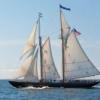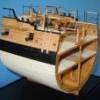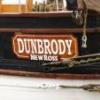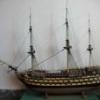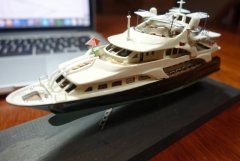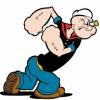-
Posts
548 -
Joined
-
Last visited
Reputation Activity
-
 Elia got a reaction from thibaultron in Swan IV, Sail Making Supplement
Elia got a reaction from thibaultron in Swan IV, Sail Making Supplement
This paper back supplement to volume IV of the The Fully Framed Model Swan series is a little gem. For those who may not see themselves building the Swan ship, but are looking for a well thought out approach to scale sails which can be displayed deployed or furled, you owe it to yourself to pick up a copy of this booklet. David presents his approach, including a multi-part jig, in clear and logical steps. The example sail he presents is square rigged sail for Swan, though one can easily employ his approach for triangular or other configurations. I plan on using this approach on my schooner's sails - none of which are square.
David uses what I will refer to as mixed media as a means of achieving his scale sails, with the basic sail material being silk span. His results are impressive, and his process appears to me that one, with a little practice, can achieve a surprisingly realistic set of scale sails. My experience with silk span sails in the past was mixed - owing to the materials and process I had read of and employed on my Oneida brig. While my sails would furl, I couldn't keep bolt ropes attached, I had difficulty with cringes, etc. I had used a PVA glue/water/acrylic paint applied to the sail, and PVA glue for all of the attached strips and ropes. [writer's note - do not follow my aforementioned materials - they will lead you to frustrating times]. David's set of materials and approach allows for clear panel lines, tablings, grommets, cringles, and reefing points. He shows how sails present light as both front and back lit, and his approach yields a very realistic semi-transparent panels and overlaps. At the end of the supplement he provides guidance on bending the sail to a yard, reeving details, and then how to furl the sails.
Highly recommended!
Elia Gianopulos
-
 Elia got a reaction from dvm27 in Swan IV, Sail Making Supplement
Elia got a reaction from dvm27 in Swan IV, Sail Making Supplement
This paper back supplement to volume IV of the The Fully Framed Model Swan series is a little gem. For those who may not see themselves building the Swan ship, but are looking for a well thought out approach to scale sails which can be displayed deployed or furled, you owe it to yourself to pick up a copy of this booklet. David presents his approach, including a multi-part jig, in clear and logical steps. The example sail he presents is square rigged sail for Swan, though one can easily employ his approach for triangular or other configurations. I plan on using this approach on my schooner's sails - none of which are square.
David uses what I will refer to as mixed media as a means of achieving his scale sails, with the basic sail material being silk span. His results are impressive, and his process appears to me that one, with a little practice, can achieve a surprisingly realistic set of scale sails. My experience with silk span sails in the past was mixed - owing to the materials and process I had read of and employed on my Oneida brig. While my sails would furl, I couldn't keep bolt ropes attached, I had difficulty with cringes, etc. I had used a PVA glue/water/acrylic paint applied to the sail, and PVA glue for all of the attached strips and ropes. [writer's note - do not follow my aforementioned materials - they will lead you to frustrating times]. David's set of materials and approach allows for clear panel lines, tablings, grommets, cringles, and reefing points. He shows how sails present light as both front and back lit, and his approach yields a very realistic semi-transparent panels and overlaps. At the end of the supplement he provides guidance on bending the sail to a yard, reeving details, and then how to furl the sails.
Highly recommended!
Elia Gianopulos
-
 Elia reacted to Mahuna in Kathryn by Mahuna - FINISHED - 1:32 - Skipjack Based on HAER Drawings
Elia reacted to Mahuna in Kathryn by Mahuna - FINISHED - 1:32 - Skipjack Based on HAER Drawings
Part 37 – Yawl Boat
Laws governing oystering in the state of Maryland have restricted dredging to sail-only for many years. Recently however, the shortage of oysters and the difficulty in getting enough crew to man the oyster dredging boats 7 days a week has caused the state to relax the laws so that dredging can be done using the push boat (called a yawl boat in the Chesapeake) for power dredging 2 days a week. This has resulted in most dredging boats only going out during their permitted 2 days.
The book “Working Skipjacks of Deal Island” by Brice Stump has some great photos of the yawl boat and its operator at work. The following photo is from the book:
The operator is helping the Kathryn’s captain maneuver the skipjack by pulling on the ropes on one side of the davit.
The configuration of the engine cover in this photo is different from the drawings in the HAER documentation.
Obviously the yawl boat has been modified over the years, but since the model is based on the HAER documents that reflect how Kathryn was configured in the mid-1990’s, the yawl boat for the model will be built as it was in that timeframe.
The HAER documentation contains line plans for the yawl boat, so these drawings were used to develop the keel and frames for the model yawl boat. The model frames are somewhat thicker than the real frames would be, but these frames would not be obvious in the model and the extra thickness provides some strength to support the planking.
A holding device (a simple block of wood tapered at the correct angle and with a 1/8” groove milled in it) was made to hold the keel at the proper angle during assembly – this allows the frames to be set vertically.
The frames were held during gluing by using two machinist squares. Given the small size of the yawl boat I didn’t think it made sense to try to replicate the jigs I used in the installation of Kathryn’s frames.
The rearmost frame is not absolutely vertical, but I didn’t think this would be a major issue.
When all of the frames were in place, chart tape was used to line off the sheer and the chine.
Using the resulting drawn lines, the sheer plank was installed on each side, and the tops of the frames were trimmed to the top of the plank.
The side planking is 1/32” thick. The sheer plank was made from 1/8” wide piece of madrone. Since the sides of the yawl boat are straight, the rest of the side planking was made from a single piece of 1/32” castello that was spiled on top and bottom.
There is a ‘locker’ at the aft of the cockpit, which will house one of the large blocks used to raise and lower the yawl boat. This was added to the model, and the interior of the yawl boat was then painted a workmanlike grey.
The exterior colors of the yawl boat mimic Kathryn’s color scheme, so the hull was painted next.
The superstructure of the yawl boat still needs to be built. This will include an exhaust pipe for the boat’s diesel engine, and will be the subject of a future post.
In the intervals between each step of Yawl Boat construction I decided to install Kathryn’s deck planks. This will be the topic for the next post.
-
 Elia got a reaction from Mahuna in Swan IV, Sail Making Supplement
Elia got a reaction from Mahuna in Swan IV, Sail Making Supplement
This paper back supplement to volume IV of the The Fully Framed Model Swan series is a little gem. For those who may not see themselves building the Swan ship, but are looking for a well thought out approach to scale sails which can be displayed deployed or furled, you owe it to yourself to pick up a copy of this booklet. David presents his approach, including a multi-part jig, in clear and logical steps. The example sail he presents is square rigged sail for Swan, though one can easily employ his approach for triangular or other configurations. I plan on using this approach on my schooner's sails - none of which are square.
David uses what I will refer to as mixed media as a means of achieving his scale sails, with the basic sail material being silk span. His results are impressive, and his process appears to me that one, with a little practice, can achieve a surprisingly realistic set of scale sails. My experience with silk span sails in the past was mixed - owing to the materials and process I had read of and employed on my Oneida brig. While my sails would furl, I couldn't keep bolt ropes attached, I had difficulty with cringes, etc. I had used a PVA glue/water/acrylic paint applied to the sail, and PVA glue for all of the attached strips and ropes. [writer's note - do not follow my aforementioned materials - they will lead you to frustrating times]. David's set of materials and approach allows for clear panel lines, tablings, grommets, cringles, and reefing points. He shows how sails present light as both front and back lit, and his approach yields a very realistic semi-transparent panels and overlaps. At the end of the supplement he provides guidance on bending the sail to a yard, reeving details, and then how to furl the sails.
Highly recommended!
Elia Gianopulos
-
 Elia got a reaction from Ryland Craze in Swan IV, Sail Making Supplement
Elia got a reaction from Ryland Craze in Swan IV, Sail Making Supplement
This paper back supplement to volume IV of the The Fully Framed Model Swan series is a little gem. For those who may not see themselves building the Swan ship, but are looking for a well thought out approach to scale sails which can be displayed deployed or furled, you owe it to yourself to pick up a copy of this booklet. David presents his approach, including a multi-part jig, in clear and logical steps. The example sail he presents is square rigged sail for Swan, though one can easily employ his approach for triangular or other configurations. I plan on using this approach on my schooner's sails - none of which are square.
David uses what I will refer to as mixed media as a means of achieving his scale sails, with the basic sail material being silk span. His results are impressive, and his process appears to me that one, with a little practice, can achieve a surprisingly realistic set of scale sails. My experience with silk span sails in the past was mixed - owing to the materials and process I had read of and employed on my Oneida brig. While my sails would furl, I couldn't keep bolt ropes attached, I had difficulty with cringes, etc. I had used a PVA glue/water/acrylic paint applied to the sail, and PVA glue for all of the attached strips and ropes. [writer's note - do not follow my aforementioned materials - they will lead you to frustrating times]. David's set of materials and approach allows for clear panel lines, tablings, grommets, cringles, and reefing points. He shows how sails present light as both front and back lit, and his approach yields a very realistic semi-transparent panels and overlaps. At the end of the supplement he provides guidance on bending the sail to a yard, reeving details, and then how to furl the sails.
Highly recommended!
Elia Gianopulos
-
 Elia got a reaction from CaptainSteve in Young America 1853 by EdT - FINISHED - extreme clipper
Elia got a reaction from CaptainSteve in Young America 1853 by EdT - FINISHED - extreme clipper
Ed
Outstanding and delicate copper work. I am very impressed by all of your copper work and these are no exception. They are such thin, narrow details. I appreciate your showing the 'blank' first step strip adjacent completed spreader bar component as I had wondered how you made the integrated cleats. I have no doubt I would bend and damage those spreaders in less than a day.
Cheers,
Elia
-
 Elia got a reaction from el cid in Swan IV, Sail Making Supplement
Elia got a reaction from el cid in Swan IV, Sail Making Supplement
This paper back supplement to volume IV of the The Fully Framed Model Swan series is a little gem. For those who may not see themselves building the Swan ship, but are looking for a well thought out approach to scale sails which can be displayed deployed or furled, you owe it to yourself to pick up a copy of this booklet. David presents his approach, including a multi-part jig, in clear and logical steps. The example sail he presents is square rigged sail for Swan, though one can easily employ his approach for triangular or other configurations. I plan on using this approach on my schooner's sails - none of which are square.
David uses what I will refer to as mixed media as a means of achieving his scale sails, with the basic sail material being silk span. His results are impressive, and his process appears to me that one, with a little practice, can achieve a surprisingly realistic set of scale sails. My experience with silk span sails in the past was mixed - owing to the materials and process I had read of and employed on my Oneida brig. While my sails would furl, I couldn't keep bolt ropes attached, I had difficulty with cringes, etc. I had used a PVA glue/water/acrylic paint applied to the sail, and PVA glue for all of the attached strips and ropes. [writer's note - do not follow my aforementioned materials - they will lead you to frustrating times]. David's set of materials and approach allows for clear panel lines, tablings, grommets, cringles, and reefing points. He shows how sails present light as both front and back lit, and his approach yields a very realistic semi-transparent panels and overlaps. At the end of the supplement he provides guidance on bending the sail to a yard, reeving details, and then how to furl the sails.
Highly recommended!
Elia Gianopulos
-
 Elia got a reaction from flying_dutchman2 in Swan IV, Sail Making Supplement
Elia got a reaction from flying_dutchman2 in Swan IV, Sail Making Supplement
This paper back supplement to volume IV of the The Fully Framed Model Swan series is a little gem. For those who may not see themselves building the Swan ship, but are looking for a well thought out approach to scale sails which can be displayed deployed or furled, you owe it to yourself to pick up a copy of this booklet. David presents his approach, including a multi-part jig, in clear and logical steps. The example sail he presents is square rigged sail for Swan, though one can easily employ his approach for triangular or other configurations. I plan on using this approach on my schooner's sails - none of which are square.
David uses what I will refer to as mixed media as a means of achieving his scale sails, with the basic sail material being silk span. His results are impressive, and his process appears to me that one, with a little practice, can achieve a surprisingly realistic set of scale sails. My experience with silk span sails in the past was mixed - owing to the materials and process I had read of and employed on my Oneida brig. While my sails would furl, I couldn't keep bolt ropes attached, I had difficulty with cringes, etc. I had used a PVA glue/water/acrylic paint applied to the sail, and PVA glue for all of the attached strips and ropes. [writer's note - do not follow my aforementioned materials - they will lead you to frustrating times]. David's set of materials and approach allows for clear panel lines, tablings, grommets, cringles, and reefing points. He shows how sails present light as both front and back lit, and his approach yields a very realistic semi-transparent panels and overlaps. At the end of the supplement he provides guidance on bending the sail to a yard, reeving details, and then how to furl the sails.
Highly recommended!
Elia Gianopulos
-
 Elia got a reaction from Canute in Swan IV, Sail Making Supplement
Elia got a reaction from Canute in Swan IV, Sail Making Supplement
This paper back supplement to volume IV of the The Fully Framed Model Swan series is a little gem. For those who may not see themselves building the Swan ship, but are looking for a well thought out approach to scale sails which can be displayed deployed or furled, you owe it to yourself to pick up a copy of this booklet. David presents his approach, including a multi-part jig, in clear and logical steps. The example sail he presents is square rigged sail for Swan, though one can easily employ his approach for triangular or other configurations. I plan on using this approach on my schooner's sails - none of which are square.
David uses what I will refer to as mixed media as a means of achieving his scale sails, with the basic sail material being silk span. His results are impressive, and his process appears to me that one, with a little practice, can achieve a surprisingly realistic set of scale sails. My experience with silk span sails in the past was mixed - owing to the materials and process I had read of and employed on my Oneida brig. While my sails would furl, I couldn't keep bolt ropes attached, I had difficulty with cringes, etc. I had used a PVA glue/water/acrylic paint applied to the sail, and PVA glue for all of the attached strips and ropes. [writer's note - do not follow my aforementioned materials - they will lead you to frustrating times]. David's set of materials and approach allows for clear panel lines, tablings, grommets, cringles, and reefing points. He shows how sails present light as both front and back lit, and his approach yields a very realistic semi-transparent panels and overlaps. At the end of the supplement he provides guidance on bending the sail to a yard, reeving details, and then how to furl the sails.
Highly recommended!
Elia Gianopulos
-
 Elia got a reaction from Seventynet in Swan IV, Sail Making Supplement
Elia got a reaction from Seventynet in Swan IV, Sail Making Supplement
This paper back supplement to volume IV of the The Fully Framed Model Swan series is a little gem. For those who may not see themselves building the Swan ship, but are looking for a well thought out approach to scale sails which can be displayed deployed or furled, you owe it to yourself to pick up a copy of this booklet. David presents his approach, including a multi-part jig, in clear and logical steps. The example sail he presents is square rigged sail for Swan, though one can easily employ his approach for triangular or other configurations. I plan on using this approach on my schooner's sails - none of which are square.
David uses what I will refer to as mixed media as a means of achieving his scale sails, with the basic sail material being silk span. His results are impressive, and his process appears to me that one, with a little practice, can achieve a surprisingly realistic set of scale sails. My experience with silk span sails in the past was mixed - owing to the materials and process I had read of and employed on my Oneida brig. While my sails would furl, I couldn't keep bolt ropes attached, I had difficulty with cringes, etc. I had used a PVA glue/water/acrylic paint applied to the sail, and PVA glue for all of the attached strips and ropes. [writer's note - do not follow my aforementioned materials - they will lead you to frustrating times]. David's set of materials and approach allows for clear panel lines, tablings, grommets, cringles, and reefing points. He shows how sails present light as both front and back lit, and his approach yields a very realistic semi-transparent panels and overlaps. At the end of the supplement he provides guidance on bending the sail to a yard, reeving details, and then how to furl the sails.
Highly recommended!
Elia Gianopulos
-
 Elia got a reaction from gjdale in Swan IV, Sail Making Supplement
Elia got a reaction from gjdale in Swan IV, Sail Making Supplement
This paper back supplement to volume IV of the The Fully Framed Model Swan series is a little gem. For those who may not see themselves building the Swan ship, but are looking for a well thought out approach to scale sails which can be displayed deployed or furled, you owe it to yourself to pick up a copy of this booklet. David presents his approach, including a multi-part jig, in clear and logical steps. The example sail he presents is square rigged sail for Swan, though one can easily employ his approach for triangular or other configurations. I plan on using this approach on my schooner's sails - none of which are square.
David uses what I will refer to as mixed media as a means of achieving his scale sails, with the basic sail material being silk span. His results are impressive, and his process appears to me that one, with a little practice, can achieve a surprisingly realistic set of scale sails. My experience with silk span sails in the past was mixed - owing to the materials and process I had read of and employed on my Oneida brig. While my sails would furl, I couldn't keep bolt ropes attached, I had difficulty with cringes, etc. I had used a PVA glue/water/acrylic paint applied to the sail, and PVA glue for all of the attached strips and ropes. [writer's note - do not follow my aforementioned materials - they will lead you to frustrating times]. David's set of materials and approach allows for clear panel lines, tablings, grommets, cringles, and reefing points. He shows how sails present light as both front and back lit, and his approach yields a very realistic semi-transparent panels and overlaps. At the end of the supplement he provides guidance on bending the sail to a yard, reeving details, and then how to furl the sails.
Highly recommended!
Elia Gianopulos
-
 Elia got a reaction from mtaylor in Swan IV, Sail Making Supplement
Elia got a reaction from mtaylor in Swan IV, Sail Making Supplement
This paper back supplement to volume IV of the The Fully Framed Model Swan series is a little gem. For those who may not see themselves building the Swan ship, but are looking for a well thought out approach to scale sails which can be displayed deployed or furled, you owe it to yourself to pick up a copy of this booklet. David presents his approach, including a multi-part jig, in clear and logical steps. The example sail he presents is square rigged sail for Swan, though one can easily employ his approach for triangular or other configurations. I plan on using this approach on my schooner's sails - none of which are square.
David uses what I will refer to as mixed media as a means of achieving his scale sails, with the basic sail material being silk span. His results are impressive, and his process appears to me that one, with a little practice, can achieve a surprisingly realistic set of scale sails. My experience with silk span sails in the past was mixed - owing to the materials and process I had read of and employed on my Oneida brig. While my sails would furl, I couldn't keep bolt ropes attached, I had difficulty with cringes, etc. I had used a PVA glue/water/acrylic paint applied to the sail, and PVA glue for all of the attached strips and ropes. [writer's note - do not follow my aforementioned materials - they will lead you to frustrating times]. David's set of materials and approach allows for clear panel lines, tablings, grommets, cringles, and reefing points. He shows how sails present light as both front and back lit, and his approach yields a very realistic semi-transparent panels and overlaps. At the end of the supplement he provides guidance on bending the sail to a yard, reeving details, and then how to furl the sails.
Highly recommended!
Elia Gianopulos
-
 Elia reacted to allanyed in Rigging and masting, Swan IV revised and expanded
Elia reacted to allanyed in Rigging and masting, Swan IV revised and expanded
I just read the chapter 26, the addition to the original volume IV which deals with making sails. This chapter alone is worth the price of the book. The details are incredible and are presented in a way that all of us can make realistic sails that are "to scale" in all ways. The difficulty in making to scale sails for popular building scales has been discussed on this site numerous times and is one reason many builders, myself included, do not like making sails. That has now changed, at least for me.
Allan
-
 Elia reacted to BobF in Modeling the Extreme Clipper Young America 1853, Volume 2 by Edward J. Tosti
Elia reacted to BobF in Modeling the Extreme Clipper Young America 1853, Volume 2 by Edward J. Tosti
Modeling The Extreme Clipper
Young America
1853
Volume 2: Deck Facilities & Pre-Rigging
By Edward J. Tosti
Florence, Oregon: SeaWatchBooks LLC, 2017
9“ x 12”, hardcover, xvi + 224 pages
Illustrations, drawings, CD, bibliography, index
ISBN 978-0-9904041-9-4
www.seawatchbooks.com, seawatchbooks@gmail.com
In his opening remarks, Edward Tosti explains why he opted to include an additional volume into what originally was intended to be a two-volume treatise on modeling the extreme clipper, YoungAmerica 1853. You may recall that it was assumed that a single second book would provide the reader with a completed, fully rigged model.
In Volume I, the author made every effort to minimize the need for precision machine tools, thus making the building of Young America more viable for the modeler who has fewer resources and experience. Unfortunately, as Tosti began the second book with the fabrication of various deck machinery, small duplicate parts, or items requiring micro-joinery, it became apparent that the use of these power tools would be more prudent if precision work was going to be maintained.
This dilemma forced the author to devote more space to setup, and the use of these tools. Thus, an additional volume was added, which allowed for a more thorough discussion of machining techniques required for the numerous pieces. It would also allow for a more in-depth coverage of the rigging phase later in Volume III.
The net result is that Volume II, with its considerable emphasis on setup and use of power tools provides modelers with a unique opportunity to learn new skills, or hone the basic abilities they already possess. This certainly makes this second book unique among works published for the model ship builder.
In the introduction the reader is advised that some subject matter covered in Volume II may be subject to interpretation since reliable references began to dwindle once Tosti got beyond the builder’s original table of offsets, the original half model, and the builder’s sail plan and engineering practices. Two photos of Young America taken in the 1870’s were also extremely helpful. Secondary resources such as early American standards documents, the structural tabulations published by William L. Crothers, comparisons with known data on other ships, and some contemporary paintings were also utilized. The author, by no means, implies that the net result of his research represents the ultimate appearance of Young America in the mid 1850’s, and encourages the individual to utilize his own discretion when building this phase of the model.
This book begins where Volume I left off. Chapter 16 discusses weather deck enclosures. In this area, Tosti feels reasonably confident about the accuracy of these structures since he was able to obtain information from the original builder’s model and the previously mentioned photographs.
Construction begins with pre-painted wall panels composed of individual planks, which are then cut to size. Structural members and other details, made from a contrasting wood, are then added. The author opted to leave the interiors exposed on the port side, and explains in detail how this was accomplished. The fabrication of ladders and skylights are also discussed in this opening chapter.
The final 10 chapters all feature extensive use of the lathe and milling machine. As stated earlier in this review, Tosti goes into considerable detail on constructing various items. Some noteworthy assemblies include the windlass, capstans, ship’s wheel, and bilge pumps. This last item is one of the more intriguing pieces with its unique flywheel design. Using a milling machine, and a series of very nice photos and sketches, the author’s technique is easily understood.
Although discussed in Volume I, for the sake of continuity, Tosti also reviews basic silver soldering techniques, which are essential in fabricating items such as the pump or three anchors. The use of various grades of silver solder and their advantages, soldering step sequencing, anti-flux products, and heat sinks are all explained.
The author’s attention to detail is exemplified by the use of two symbols in the index and next to the headers for various construction segments. The anchor, which has also been used in Tosti’s HMS Naiad series, denotes a re-usable process. In the Young America treatise, Ed has added the crossed file and hammer symbol, which indicates a special tool/device.
An example would be the molds or plugs used to construct ship’s boats. Ed Tosti devotes an entire chapter to these small craft, and provides plans for four different types. They include three different sizes of cutter and a 28-foot longboat. Three of these craft are carvel planked, while the 24-foot cutter features lap-strake or clinker style construction. The author’s description for building these models is most noteworthy, particularly the lap-straked cutter.
So far, this review has concentrated on the more complex assemblies found on the Young America. Yet, it is the fabrication of smaller, more numerous fittings that can cause our hobby to become somewhat tedious. They include belaying pins, stanchions, cleats, chocks, deadeyes, backing links, eyebolts, shackles, and bullseyes. The author addresses all of these items in great detail, and offers hints and tips that will help expedite their construction while maintaining a high level of quality.
Volume II comes with a single 1:96 scale drawing, which features an overall deck arrangement, and external sheer plan. Those who prefer the 1:72 scale will find printable, letter sized sheets on the CD that comes with this book. The drawing, designated as Drawing 11, coincides with the final chapter in Volume II, which deals with preparing for masts and rigging. The locations for all the rigging connection points on the deck and outer hull are illustrated on this sheet.
It is this writer’s belief that the second book in a series of this type can be the more interesting, and it is only because it deals with so many different sub-assemblies and details. Add to that the machining process tutorials this book contains, and Young America 1853 Volume 2, certainly reinforces that belief.
With over 200 pages, 500+ photos and illustrations, a CD containing tables, templates and patterns, and 12 full-color photos, this book represents a ship modeling tour de force for nineteenth century merchant vessels. It is highly recommended.
Reviewed by BobF
-
-
 Elia reacted to EdT in Young America 1853 by EdT - FINISHED - extreme clipper
Elia reacted to EdT in Young America 1853 by EdT - FINISHED - extreme clipper
More like less than an hour for me, Elia.
-
 Elia got a reaction from mtaylor in Young America 1853 by EdT - FINISHED - extreme clipper
Elia got a reaction from mtaylor in Young America 1853 by EdT - FINISHED - extreme clipper
Ed
Outstanding and delicate copper work. I am very impressed by all of your copper work and these are no exception. They are such thin, narrow details. I appreciate your showing the 'blank' first step strip adjacent completed spreader bar component as I had wondered how you made the integrated cleats. I have no doubt I would bend and damage those spreaders in less than a day.
Cheers,
Elia
-
 Elia got a reaction from Omega1234 in Arethusa 1907 by Elia - Knockabout Banks Fishing Schooner
Elia got a reaction from Omega1234 in Arethusa 1907 by Elia - Knockabout Banks Fishing Schooner
Oh I feel a drop off in productivity nearing...
these all just arrived...
-
 Elia got a reaction from tlevine in Arethusa 1907 by Elia - Knockabout Banks Fishing Schooner
Elia got a reaction from tlevine in Arethusa 1907 by Elia - Knockabout Banks Fishing Schooner
Oh I feel a drop off in productivity nearing...
these all just arrived...
-
 Elia got a reaction from bhermann in Arethusa 1907 by Elia - Knockabout Banks Fishing Schooner
Elia got a reaction from bhermann in Arethusa 1907 by Elia - Knockabout Banks Fishing Schooner
Oh I feel a drop off in productivity nearing...
these all just arrived...
-
 Elia reacted to EdT in Young America 1853 by EdT - FINISHED - extreme clipper
Elia reacted to EdT in Young America 1853 by EdT - FINISHED - extreme clipper
Hi Micheal,
You have noticed another case of my taking pictures with discrepancies between the drawings and the work. My apologies to all for these differences. They occur when I elect not to print the latest revision for use in the shop - a very bad practice, but one I reluctantly sometimes adopt in the interest of saving 11 x 17 printer paper and ink. Unlike the recipients of my final drawings, I am usually doing drawing revisions "just-in-time" for construction because before constructing something I usually go back and make sure my best current data is reflected on the drawings. In this case the dimensioned construction drawing for the spar had been updated and printed for use in making the spar correctly, but not the mast detail sheet which was still undergoing revision - mainly for upper mast details like rigging line numbers. Snippets from the current detail drawing and spar construction are shown below. You will note the difference from the first two drawings in the post above. The square heeling has been shortened to correct size (2.5 X mast diameter) and the location of the fid hole updated based on the final drawing of the top. The bottom of the hole is 1" + the depth of the trestle trees above the mast bottom. These dimensions are shown on the spar construction drawings but not on the detail sheets.
Again sorry for this confusion. I should be more careful or at least note when these differences occur.
Thanks, Micheal. I like it when people look closely.
Ed
-
 Elia reacted to EdT in Young America 1853 by EdT - FINISHED - extreme clipper
Elia reacted to EdT in Young America 1853 by EdT - FINISHED - extreme clipper
Young America - extreme clipper 1853
Part 229 – Fore Topmast 2
The first stages in making the fore topmast were described in Part 226. There are just a few details to be added in this part. The first picture shows the lower sheave ready to be installed.
All slots through the mast were cut with a 1/32" milling cutter, so in most cases some enlargement is required to accommodate other parts. Slight enlargement of this sheave opening was done with the small diamond grit file in the picture to widen the slot to a scale 3". The 2½" thick sheave with a diameter equal to the mast at its position was turned in brass on the lathe. This sheave was used to raise the mast by means of a tackle hooked to the foremast cap. The sheave is angled on the mast so the that rope will clear the close, square opening in the fore top. The next picture shows the topmast fid.
The dimensions of this substantial piece of iron may be seen in the photo. The slot for this piece was also widened with a small file. The next picture shows the lower end of the topmast temporarily in position.
In practice the topmast would be raised up through the opening in the top and through the cap from below. The mast would then be fitted with the futtock band and the crosstrees. On the model the topmast will be slipped through the cap only, then fitted with the upper details including futtock shrouds. Then the whole assembly will be set in place from above. Because the futtock band will not fit through the cap, it was installed after the cap was slipped over the mast. The method for fixing the band is shown in the next picture.
The band is placed below the hounds, which flare out to seat the crosstrees, so it cannot be pre-made and slipped over. The tab shown in the picture was crimped to hold the band and also to simulate the bolted, clamping flange that would have been used. Obviously this piece could not be soldered. The band will be fixed to its position when the four futtock shroud eyebolts are added through holes drilled in the band and into the mast. The completed band and eyebolts are shown in the next picture.
The picture also shows the sheave for the upper topsail halyard tie installed, as well as the seat at the top of the hounds for the crosstrees. Those crosstrees will be described in the next part.
Work on these mast parts has been interspersed with "rattling down" of the lower shrouds. The last picture shows this work completed on the starboard side of the fore mast.
Ed
-
 Elia reacted to Jeronimo in Chebece 1750 by Jeronimo - FINISHED
Elia reacted to Jeronimo in Chebece 1750 by Jeronimo - FINISHED
Hello friends,
I had a terrible surprise after the holiday in my workshop.
A small water damage had destroyed my model in time.
Frames and planks, all skewed and oblique.
No more save.
After numeros curses and frustation, the result:
" New construction of the model ".
A German proverb is: all good things are three.
Hallo Freunde,
eine schlimme Überraschung hatte ich nach dem Urlaub in meiner Werkstatt.
Ein kleiner Wasserschaden hatte in der Zeit mein Modell zerstört.
Spanten und Planken , alles verzogen und schief.
Nicht mehr zu retten.
Nach zahllosen Flüchen und Frustabbau, Folge daraus:
"Neubau des Modelles".
Ein deutsches Sprichwort lautet: Alle guten Dinge sind drei.
Karl
PART 1
-
 Elia reacted to tlevine in HMS Atalanta 1775 by tlevine - FINISHED - 1:48 scale - from TFFM plans
Elia reacted to tlevine in HMS Atalanta 1775 by tlevine - FINISHED - 1:48 scale - from TFFM plans
I have finally had some time to devote to the workshop. Last weekend was spent chasing the eclipse in Kentucky and testing (tasting) the Bourbon Trail. Time very well spent. After all...it was educational!
Next up were the head timbers. Atalanta had three; some of the Swan class ships had four. These were a royal pain-in-the-you-know-where to fabricate. They have to fit the stem assembly as well as meet the main rail. They also have the same camber as the grating. The notches at the base of the timbers are because the various components of the stem assembly did not mate perfectly way back when. I decided I would to more damage than it was worth to make it better and so modified the head timbers to fit instead. In the second picture, one can see how the third head timber (the largest) fits under the head beam. Each beam is a different thickness, with the fore beam being the thinnest. This is most readily seen in the third picture. These photos are all taken while the timbers were being shaped and so do not fit correctly at this stage.
The next step is to cut an opening in the head timbers to accommodate the middle rail. This was simply a matter of trial and error, many hours and even many more expletive deleted's. As I mentioned in a previous post, in the first timber the slot for the middle rail needed to be cut from the bottom rather than from the outer edge. The next item was the head saddle which extends from the fore ends of the main rail to the tip of the stem. I started with an oversize piece of wood and carved the underside to fit first. Then I cut the upper face and finally finished it on the model. Now everything is ready for assembly.
The covering boards are 1" thick and cover the outer edge of the head timbers. They have two panels carved into them. Looking at the next photo I now see that the third timber needs to be unglued and re-positioned to make it perpendicular to the water line. Hopefully I can accomplish that without damaging anything else. The holes from the brass pins also need filling.
-
 Elia got a reaction from popeye the sailor in 1949 Chris-Craft 19' Racing Runabout by gjdale - FINISHED -Dumas - 1:8 Scale - RADIO
Elia got a reaction from popeye the sailor in 1949 Chris-Craft 19' Racing Runabout by gjdale - FINISHED -Dumas - 1:8 Scale - RADIO
Grant,
Wow! What a stunning runabout. The time, approaches, and attention to detail you've put in have really paid off - this is such a beautiful model!
Cheers,
Elia
-
 Elia got a reaction from mtaylor in 1949 Chris-Craft 19' Racing Runabout by gjdale - FINISHED -Dumas - 1:8 Scale - RADIO
Elia got a reaction from mtaylor in 1949 Chris-Craft 19' Racing Runabout by gjdale - FINISHED -Dumas - 1:8 Scale - RADIO
Grant,
Wow! What a stunning runabout. The time, approaches, and attention to detail you've put in have really paid off - this is such a beautiful model!
Cheers,
Elia


